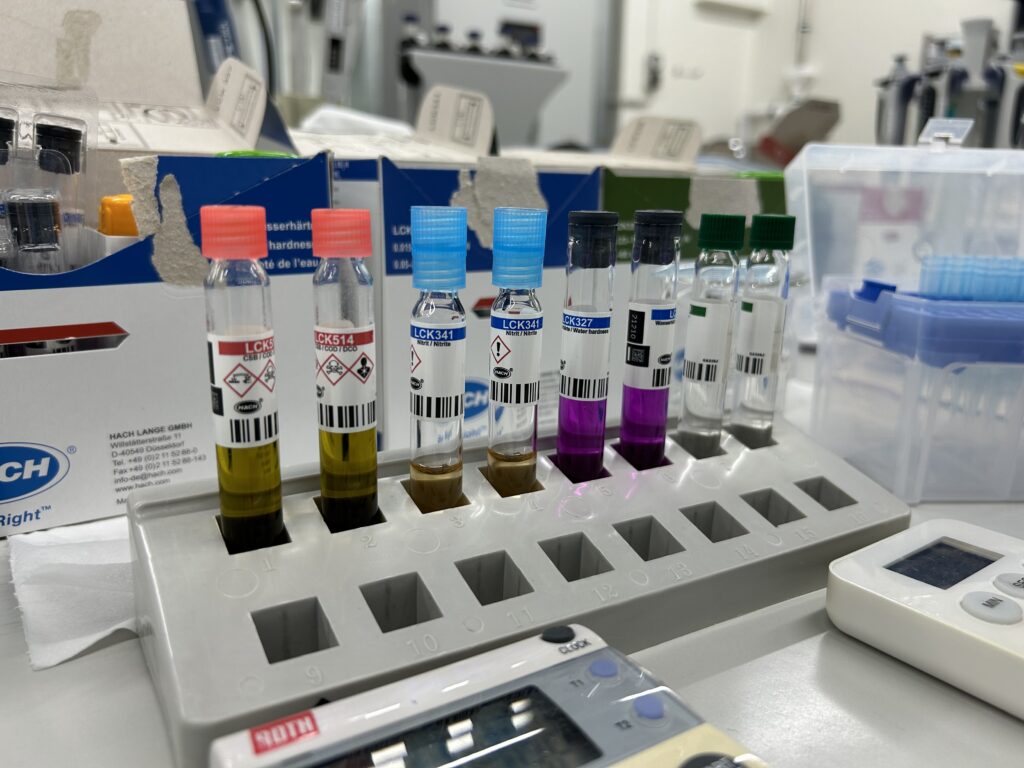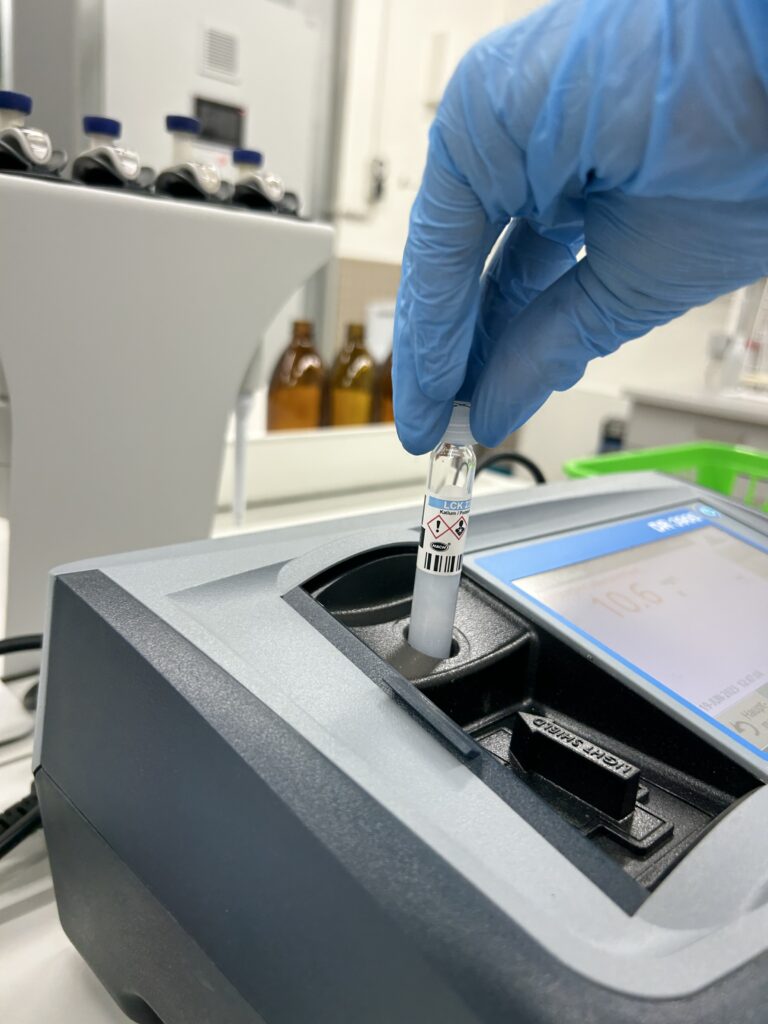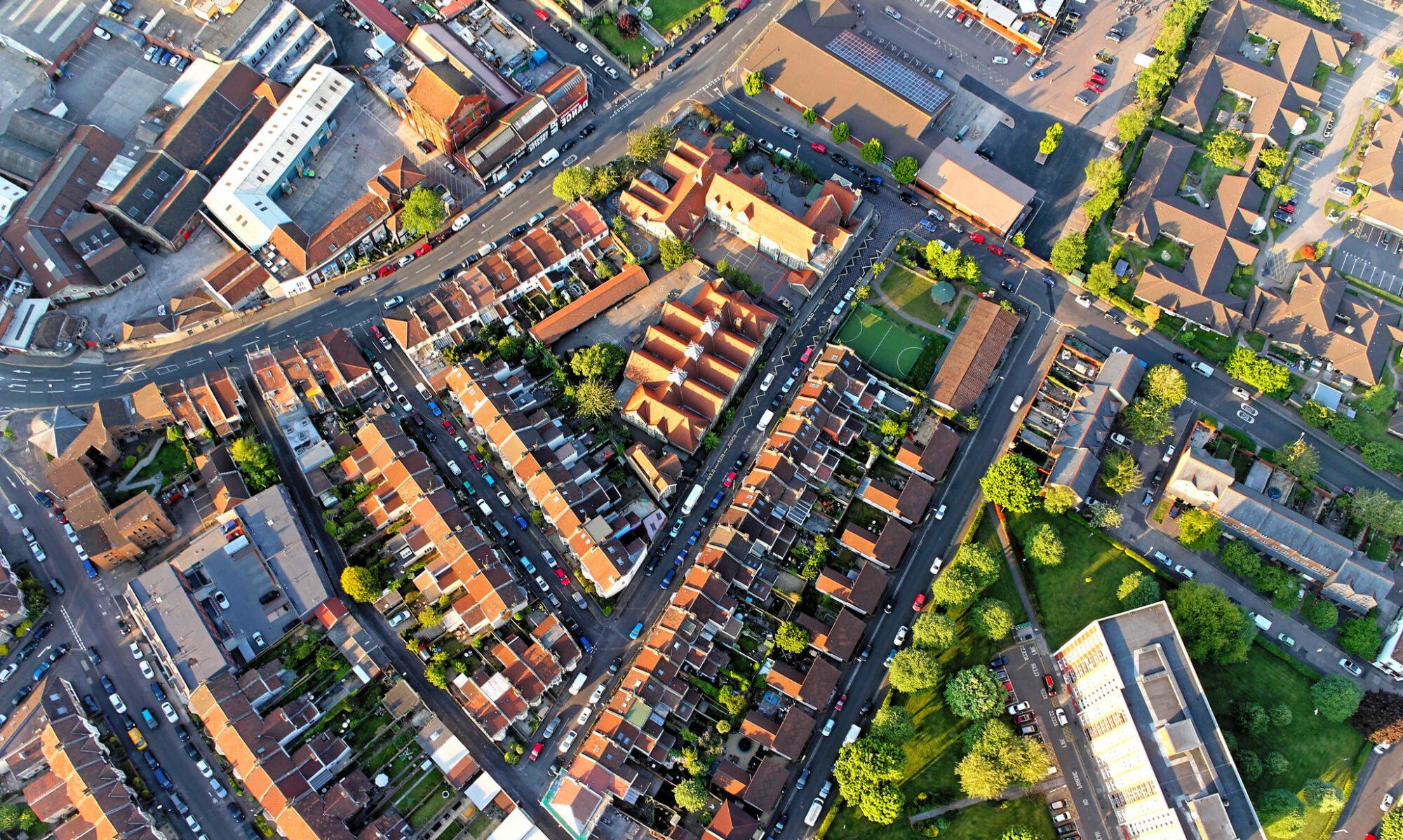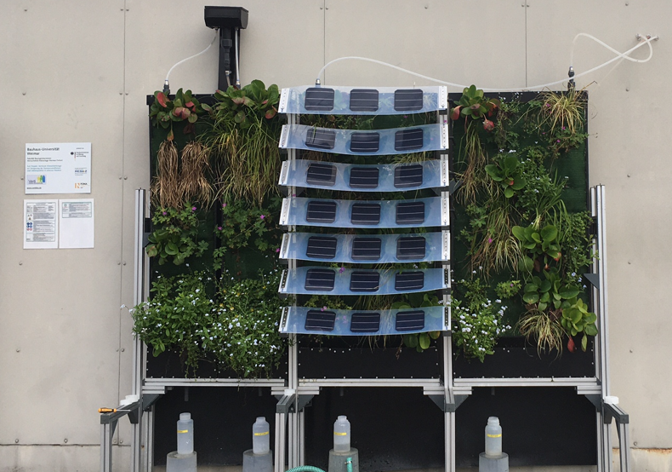VertiKKA2 – VertiKKA, a vertical air-conditioning and water recycling system

VertiKKA is a response to land use pressure in cities and combines green with renewable energy production. The VertiKKA is a multifunctional façade greening module that is irrigated with grey water. Furthermore, it generates electricity through an installed PV module. In addition to cooling and energy production, it offers a possibility for the separate treatment and discharge of partial flows of wastewater produced in the household.
Green your City
Climate change brings many challenges, especially in densified cities. Urban planning is faced with the problem of increasing densification of urban spaces and less space for urban greenery. Façade greening can enormously increase the proportion of greenery in cities, even with little available space, and offers a wide range of advantages.
The innovation of the facade greening module lies in its multifunctionality: façade greening, grey water purification and energy generation through photovoltaics are combined. The positive effects lie in the combination of the individual advantages of façade greening systems and photovoltaic modules, which generate electricity and at the same time protect the plants from extreme weather conditions. The combined grey water treatment provides the plants with nutrients and a permanent supply of water, so that the use of drinking water can be completely dispensed with.

© Bauhaus-Universität Weimar

From container to wall
In the first funding phase, different variants were developed and optimized in test modules with regard to the components photovoltaic, greywater purification performance and plant vitality. The results regarding the purification performance of the module showed a good degree of reduction of the chemical oxygen demand (COD) of the artificially mixed greywater and no restrictions on plant vitality. The building physics investigations revealed a demonstrable improvement in the microclimate in the city by lowering the air temperature and the mean radiation temperature in urban areas in summer. The numerical simulation of the hygrothermal behaviour of an outer wall showed improved thermal insulation and a lower heat flow density through the wall when using wall-bound greening.
And into the planning
The implementation and consolidation phase is built upon these results. The aim is the successful scientific, technical and impact-related further development of the VertiKKA module. The former container wall is now replaced by a façade of a building of the Bauhaus-Universität Weimar. For this real laboratory, VertiKKA modules are attached to a wall. There, the cleaning performance using real greywater, the determination of the renewable electricity yield and other important effects (e.g. cooling of the environment, protection of the outer wall, fire protection, etc.) are examined.
The aim is to show the advantages of green spaces in cities within the restrictions of missing space and drinking water. Especially larger cities are looking for solutions.
A software application is being developed to classify and evaluate the VertiKKA in comparison to other blue-green infrastructure measures. The most effective measures should be selected according to objective standards so that further planning steps can be initiated based on them.
As one measure, VertiKKA combines blue and green infrastructure planning. With a successful presentation of the positive overall effects, a rethinking of the possibilities of greywater use in the city and the need for greening is pushed.
Project title
VertiKKA2 – VertiKKA, a vertical air-conditioning and water recycling system
Internet
vertikka.de/en
Duration
01.07.2022–30.06.20224
Funding code
033W108AN
Contact
Vera Middendorf
Björnsen Beratende Ingenieure GmbH
+49 2501 5946915
v.middendorf@bjoernsen.de
Project partners
Björnsen Beratende Ingenieure GmbH
IZES gGmbH – Institut für ZukunftsEnergie- und Stoffstromsysteme
ifak – Institut für Automation und Kommunikation e.V.
Solyco Technology GmbH
Bauhaus-Universität Weimar
Version of
Juni 2023
Information on the first funding phase (2019 – 2022) can be found here
Results
Results of the second funding phase
Results of the first funding phase
Results of 2019 – 2022 –
Contribution to the publication of the results of the first funding phase Vertikale KlimaKlärAnlage zur Steigerung der Ressourceneffizienz und Lebensqualität in urbanen Räumen
Results of 2021 -Contribution to the RES:Z-Newsletter 3: Das Fassadenmodul in der Erprobung
Results of 2020 – Contribution to the RES:Z-Newsletter 2: Funktionale Fassadenbegrünung
Results of 2019 – Contribution to the RES:Z-Newsletter 1: Mehr Grün in die Stadt!
Publications
Alsaad, H., Hartmann, M., Voelker, C.: The effect of a living wall system designated for greywater treatment on the hygrothermal performance of the façade. In: Energy and Buildings 255 (2022) 111711.
Vera Middendorf, Nadja Becker, Matthias Schulz: Vertikale Klima-Klär-Anlage: Grauwasserreinigung und -nutzung durch Fassadenbegrünung. In: Transforming Cities 3 (2021), S. 20-21.
Alsaad, Hayder; Hartmann, Maria; Voelker, Conrad. The effect of a living wall system designated for greywater treatment on the hygrothermal performance of the facade. Energy and Buildings 2022;255:111711. https://doi.org/10.1016/j.enbuild.2021.111711.
Alsaad, Hayder; Hartmann, Maria; Voelker, Conrad. Hygrothermal simulation data of a living wall system for decentralized greywater treatment. Data in Brief 2022;40:107741. https://doi.org/10.1016/j.dib.2021.107741.
Alsaad, Hayder; Hartmann, Maria; Hilbel, Rebecca; Voelker, Conrad. The potential of facade greening in mitigating the effects of heatwaves in Central European cities. Building and Environment 2022;216:109021. https://doi.org/10.1016/j.buildenv.2022.109021.Alsaad, H., Hartmann, M., Voelker, C. (2022a): The potential of facade greening in mitigating the effects of heatwaves in Central European cities, Building and Environment 216, 109021. https://doi.org/10.1016/j.buildenv.2022.109021.
Alsaad, Hayder; Hartmann, Maria; Hilbel, Rebecca; Voelker, Conrad. ENVI-met validation data accompanied with simulation data of the impact of facade greening on the urban microclimate. Data in Brief 2022;42:108200 (submitted). https://doi.org/10.1016/j.dib.2022.108200.
Alsaad, Hayder; Engelhardt, Miriam; Voelker, Conrad. Messtechnische Untersuchung der Auswirkung von Fassadenbegrünungen auf den U-Wert der Außenwand. Bauphysik 2022;44(4):211-219 (submitted). https://doi.org/10.1002/bapi.202200017.
Vu Tran Le (2022): Genehmigungsrechtliche Anforderungen von Photovoltaik-Fassaden in urbanen Räumen. In: Solarzeitalter 1-2022, S. 25-27.
Schinkel, U.; Becker, N.; Trapp, M.; Speck, M. (2022): Assessing the Contribution of Innovative Technologies to Sustainable Development for Planning and Decision-Making Processes: A Set of Indicators to Describe the Performance of Sustainable Urban Infrastructures (ISI). In: Sustainability 14(4):1966



